Nazareth
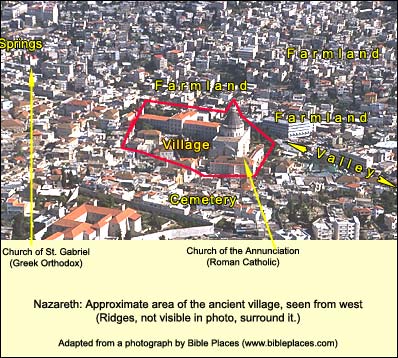
Today Nazareth is the largest Arab city in Israel, numbering 76,000 (70% Muslims and 30% Christians). The conical dome of the Roman Catholic Church of the Annunciation stands out among many smaller buildings, a constant landmark. Just north of it stands the Church of St. Joseph. The Franciscan property containing these churches probably covers most of the ancient village. Just to the west (where Casa Nova is today) was the cemetery. To the east was a valley (now Pope Paul VI street) and then a large field. About 500 yards outside the town, at the base of the northern slope, there are three springs whose water is channeled today into the Greek Orthodox Church of St. Gabriel.
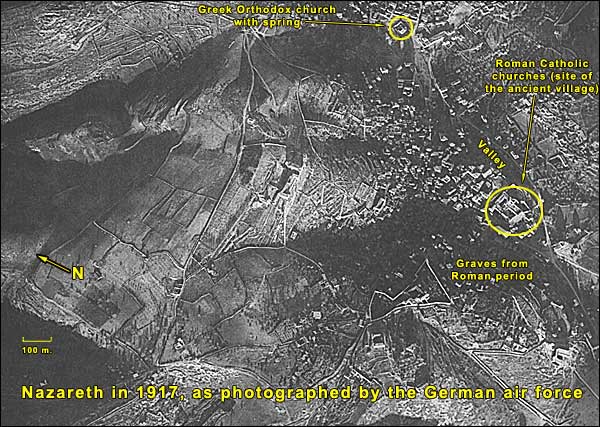
The Nazareth of Jesus' youth had but a few hundred people. Archaeological excavations have revealed little but rock-cut installations, such as tombs from the Middle Bronze Age (2100-1550 BC), silos from the Iron Age (1200-586 BC) and, from later periods, parts of olive and wine presses, cisterns, and holes for storage jars. Amid the zealous search for sacred connections, some of these have achieved cultic status (probably unwarranted). (Horsley,Horsley, Richard A. Archaeology, History, and Society in Galilee. Valley Forge: Trinity Press, 1996 p. 109) The most dramatic find is the earliest known inscription containing the words "Hail, Mary," from the early 5th century, roughly inscribed by someone in Greek at the base of a column. The most splendid discovery dates from the Crusaders: a series of well-preserved capitals, buried for safekeeping in a cavern after the victory of Saladin in 1187, depicts scenes from the lives of the Apostles. These finds and others may be viewed in the museum of the Roman Catholic Church.Beside the Nazareth of Jesus' youth was a much bigger town, Yapha, atop the ridge to the south (Yafia today). Josephus FlaviusJosephus Flavius (36 – 100 AD), Jewish general, one of two directing the revolt against Rome in Galilee. After Vespasian captured him, he prophesied the latter would be emperor. When this proved true, the Romans honored him. He then turned historian, writing The Jewish War, The Antiquities of the Jews and many other books. Because of a paragraph about John the Baptist (and maybe a sentence about Jesus), the Church preserved his works. fortified it with a double wall during the first Jewish revolt against Rome (66-70AD), and it was the scene of a major battle. Above its Greek Orthodox church are scant remains of an ancient synagogue, including elements reminiscent of synagogues from the third and fourth centuries AD. Four miles to the northwest of ancient Nazareth lay the first capital of Galilee under Herod Antipas: Sepphoris (called Tzippori in Hebrew). Between Yapha and Sepphoris, two important towns, Nazareth itself was so insignificant that it fails to get a mention either in the First Testament (though it existed then) or in Josephus. The latter names more than sixty localities in Galilee, but not it. In view of the town's unimportance, we can understand Nathanael's amazement: "Can any good thing come out of Nazareth?" (John 1:46) Pilate was joking, perhaps, when he let it be inscribed on the cross: "Jesus of Nazareth, King of the Jews." The insignificance of the place is evidence (in addition to the word of the Gospels) that Jesus really did grow up here. No one, inventing a town for his Messiah, would have placed him in Podunk! Later, Nazareth must have been more substantial. In the 2nd century AD, many Galilean cities still lay in waste as a result of the first revolt against Rome (66-70 AD). Another revolt in 132-135 (led by Bar Kokhba) occurred, it would seem, in Judaea only. The Emperor Hadrian punished the Judaeans by prohibiting circumcision, thus forcing the pious to leave. Among them were the 24 priestly families whose ancestors had officiated in the Temple. Each of these resettled in a town in Galilee. According to an inscription found in a 5th-century synagogue at Caesarea Maritima, one of the priestly families (that of Happizzes, mentioned in 1 Chronicles 24:15) made its home in Nazareth. The situation of the village, nestled in its mountain valley, might tempt us to think it was tucked away from the world. Not so. Jesus had only to climb the southern rim of the ridge to see the Jezreel Plain spreading below. Having read the Song of Deborah (Judges 5) in school, he had before him the whole theatre of the battle with the Canaanites (as well as the future Armageddon ). It was from this ridge that his townsfolk, according to Luke 4:29Luke 4:29 [A]nd they got up and drove Him out of the city, and led Him to the brow of the hill on which their city had been built, in order to throw Him down the cliff., would later attempt to throw him. (The view from the ridge). Crossing to the town's northern rim, Jesus would have seen the acropolis of Sepphoris (see map above). This city must have carried bitter associations for the villagers. In Jesus' infancy, after the death of Herod the Great, it had risen in revolt, and the Romans had taken rough revenge, selling the inhabitants as slaves. The scars would still have been fresh. The Galileans also groaned, no doubt, under the burden of taxes and rents that they had to pay to maintain the aristocrats of such a luxurious city, especially Herod's son, the tetrarch of Galilee, Antipas. Relatives of Jesus, who believed in him as the Christ, continued to live in Nazareth in the centuries before the first church was built here. During the persecution by Decius (249-51), a man named Conon was arrested. He told the court: "I am from the city of Nazareth in Galilee. I am of the family of Christ, to whom I offer a cult [which has existed] from the time of my ancestors." Thus, in Nazareth, there seems to have been a continuous presence of believers . They may have preserved the memory of the house where Mary lived. In that case, they could have shown the spot to the founder of the Byzantine church of the Annunciation, the remains of which one sees inside today's Roman Catholic Church. This founder may have been the Deacon Conon of Jerusalem, who lived in the early 5th century: his name is inscribed in a mosaic on its northwest side. {mospagebreak title=Annunciation }The Roman Catholic Church of the Annunciation The large church we see today is modern, built from 1954 - 1970, but it incorporates the ruins of its forebears. In commissioning the work, the Franciscans specified three M's: it should be modern (in the spirit of Vatican II), multinational and, above all, it should bring to expression the mystery of the Annunciation: that is, of the meeting between the divine and the human. The church is clearly modern in style. Its multi-nationality is manifest in its art works, showing how the peoples of the world envision Mary and child. Most interesting, however, is the way in which the architect, Giovanni Muzio, brought out the mystery. To see this, we need to study the structure: The building contains two churches. The lower one, simple in form, is for the use of pilgrim groups, whereas the upper, elaborate church is for the local congregation. Between the two is a large octagonal opening called the "oculus," literally "eye." The modest lower church may be said to represent the human dimension. It includes the ruins of a Byzantine church, and on its north side is a cave. Here tradition places the Annunciation. There are even two ancient pillars marking the places where Mary and the angel stood. More likely, though, the house was above, and only this cave-basement has remained. If we assume a continuous Christian presence in NazarethDuring the persecution by the Emperor Decius (249-51 AD), a man named Conon was put on trial. He said, "I am from the city of Nazareth in Galilee. I am of the family of Christ, to whom I offer a cult from the time of my ancestors." from the 1st century, it is possible that the faithful kept the memory of where the event had occurred. The upper church expresses the divine dimension. First there is the light source: the dome itself, which blossoms over the oculus like a lily. (The Hebrew root of "Nazareth" means "blossoming," and the white lily is holy to Mary.) Behind the altar a huge mosaic shows Christ in glory, with Peter and Mary beside him, while below the Popes and pilgrims process. On the walls are the multinational representations of Mary and child. Over and over in the design one sees the letter M -- or AVM, for Ave Maria. The impression is one of articulate grandeur. The divine is above, the human below, and between them is the oculus, the opening. If one stands in the upper church when a pilgrim group sings Mass in the lower, the song rises up, and in the air of the oculus one can sense the encounter.
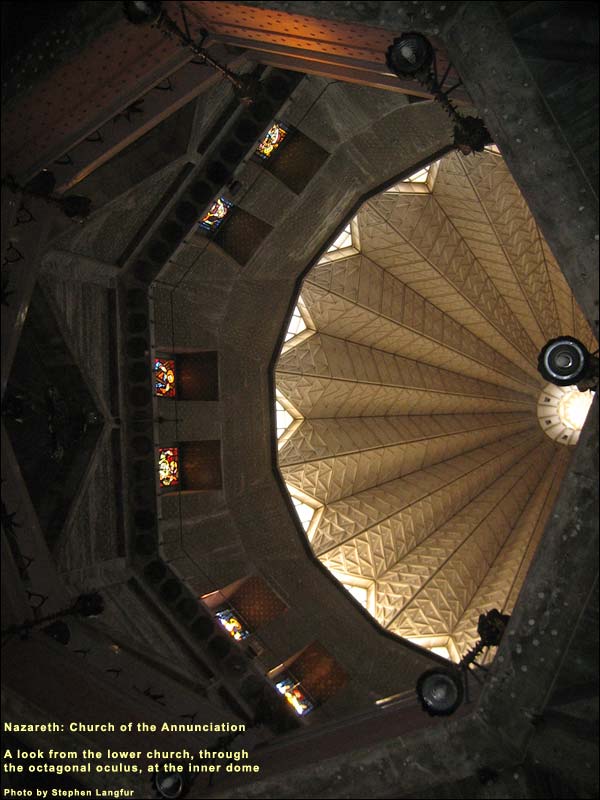
{mospagebreak title=The Spring}The spring in the Church of St. GabrielAt the base of the northern slope are three springs, whose water flows 54 feet through a rock-cut channel into the Greek Orthodox Church of St. Gabriel (built in 1750, although containing Crusader remains). Here one can see and hear the water. It then continues underground for 500 feet to a structure called Mary's Well (first built in 1862 and now restored). This gushing water is significant for two reasons. First, it is Nazareth's biggest source, flowing at the rate of 1000 gallons per hour by winter's end (250 in summer). Although there were several smaller springs around the village, and people had cisterns in their homes as well, Mary might well have come to this spring with other women of the village to do the washing. In the West Bank today, many villages still lack piped water (not by choice!), and one sees the women at the major spring on laundry day. Around them their children play. So you have at once the music of the spring, the talk of the women and the squealing of the children. That would have been the scene here also, 2000 years ago. Today we still have the music of the spring. Secondly, there is an ancient tradition about this spring. In the Protoevangelium of James, a non-canonical gospel dating to the second century, we read that Mary was one of seven unblemished virgins from the line of David who were supposed to weave a new curtain for the Holy of Holies in the Temple. It was her task to spin purple and scarlet threads. (That is why, in the iconography, she is sometimes depicted spinning.) And then we read: "She took the jar and went out to fetch water. Then a voice spoke to her: 'Greetings, you who have received grace. The Lord is with you, you blessed among women.' She looked right and left to see where the voice came from and began to tremble. Then she went back into the house, put the jar aside, sat down, took the purple and began to spin. Then an angel stepped before her..."
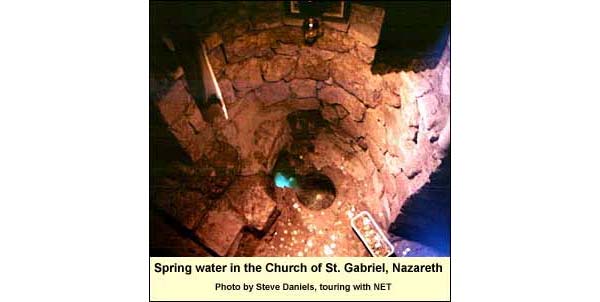
The rest follows as in Luke 1:26-38. It doesn't say, of course, that Mary went so far as the spring. (In fact, Nazareth isn't mentioned in the Protoevangelium of James; the scene takes place near the Temple in Jerusalem.) The tradition developed, nonetheless, that the first Annunciation occurred here. There is also a logic in its happening near the spring. When we remember the First Testament passages where a stranger addresses a woman, it is done with propriety at a spring or well, for this is a public place. At the watering spot, Abraham's servant finds a bride for Isaac. So Jacob meets Rachel, and Moses, Zipporah. So too, Gabriel. Angels had not yet developed wings. {mospagebreak title=Ridge view }The View from the Nazareth RidgeOn the ridge south of Nazareth there is a marvelous panorama over the Jezreel Plain. We can see, from east to west (left to right): the southern rim of the Sea of Galilee, Mt. Tabor (the mountain of the Transfiguration), the dip into the Jordan valley with the Kingdom of Jordan beyond it, En Dor (where Saul consulted with the witch), the Hill of Moreh (due south), and near the base, in the middle, the village of Nain (where Jesus raised from death the only son of a widow).
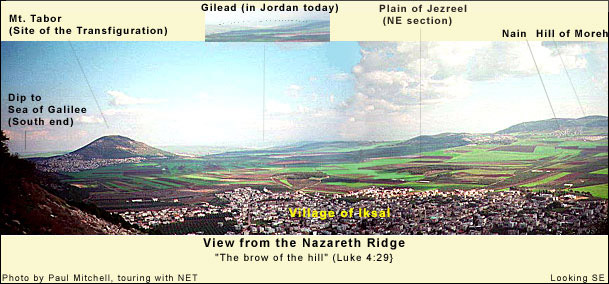
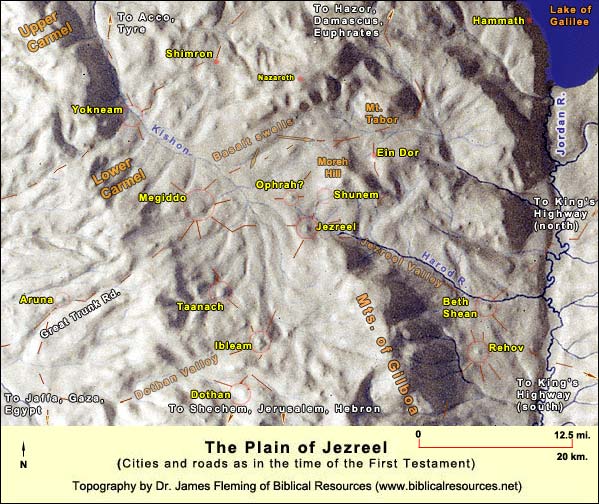
On the western side of Moreh is part of Afula, a modern Jewish city, and just beyond it one can see a sliver of Mt. Gilboa, with the central mountain range behind it. To the right the plain stretches southward toward Jenin in the West Bank. On the far right one can make out a V in a distant mountain ridge: it is the pass that comes out by Megiddo, which lies just to the right of the V. Below us spreads an Arab village called Iksal, site of the village Exaloth in the Roman period. From here one can see how the Canaanites, possessing the plain, cut the Israelite tribes off from one another, so that "travelers went by roundabout ways" (Judges 5: 6) until Deborah "arose, a mother in Israel" (Ju.5:7). Judges 4, Judges 5. There are many fish ponds and reservoirs: the natural drainage is poor, and unless such measures are taken, rain turns much of the plain to bog and swamp. The Canaanite general, Sisera, committing his 900 iron chariots to the field (Judges 4:3), must not have expected rain. Perhaps the battle occurred outside the rainy season. That would explain why Barak, the Israelite general, insisted that Deborah be present (Judges 4:8): he wanted the prophetess to signal the coming of the miraculous rain. It came, we are told, "from Seir... from the field of Edom" (Judges 5:4), today the area of southern Jordan and the western coast of Saudi Arabia. Just to our right (west), as part of the ridge on which we stand, we can see a gray promontory. In local tradition, this is the place from which the people of the Nazareth synagogue meant to throw Jesus (textLuke 4:14-31And Jesus returned to Galilee in the power of the Spirit, and news about Him spread through all the surrounding district. And He began teaching in their synagogues and was praised by all.).
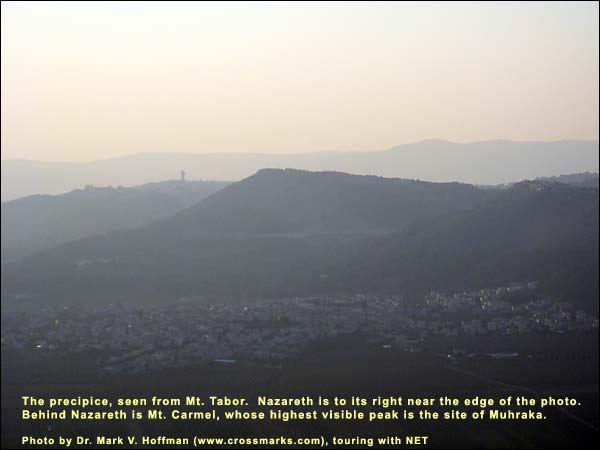
If you want to view this material on a live tour guided by Dr. Steve Langfur, please start here .
{mospagebreak title=Logistics}Logistics The churches require modest dress. Visiting hours: The Roman Catholic Church of the Annunciation and St. Joseph's Church (Telephone: 04/6572501) 8.00 - 18:00Limited rest rooms are available at the end of the visit, just before the exit. The Greek Orthodox Church of St. Gabriel, containing the spring (Telephone: 04/6576437) Open: 8.00 - 12.00, 13.00 - 17.00, but on Sundays or holidays phone in advance. If you are satisfied with your visit, you may leave a donation for the church at the door. Time permitting, it is good to walk between these two churches through the colorful suk (bazaar), which is intended not so much for tourists as for the local inhabitants. These narrow alleys are the oldest part of Arab Nazareth, although the more ancient village of Jesus' youth was confined to the hill between St. Joseph's Church and the Roman Catholic Church of the Annunciation.